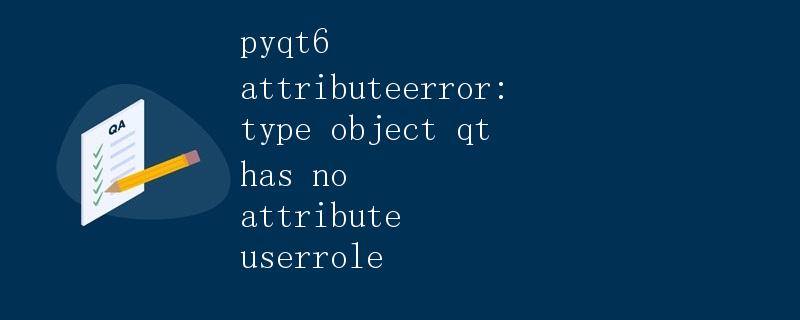PyQt6属性错误:type object Qt没有属性userRole

在使用PyQt6开发GUI应用程序时,经常需要设置和处理表格中的数据。PyQt提供了QStandardItemModel类和QStandardItem类来管理和展示表格中的数据。其中,QStandardItemModel类用于管理表格数据,而QStandardItem类用于表示每个单元格中的数据项。
在使用QStandardItem类时,我们经常会用到setData()和data()方法来设置和获取数据。这两个方法允许我们设置和获取与数据项相关联的角色(Role)。常见的角色包括Qt.DisplayRole、Qt.EditRole、Qt.ToolTipRole等。然而,有时候我们可能会遇到AttributeError错误,提示 type object Qt has no attribute userRole。本文将解释这个错误的原因,并介绍如何正确地使用userRole。
错误原因
在PyQt6中,Qt类没有userRole属性。因此,使用Qt.userRole时会导致AttributeError错误。通常,userRole用来自定义角色以存储特定数据,这样我们可以在数据模型中存储更多的信息。然而,由于userRole在PyQt6中不存在,我们需要寻找其他方法来实现相同的功能。
解决方法
为了自定义角色并存储特定数据,我们可以使用Qt.UserRole属性。Qt.UserRole是一个特殊的角色,它定义为Qt.ItemDataRole(0x0100)。我们可以通过设置大于Qt.UserRole的值来自定义角色。
下面是一个示例代码,演示如何使用Qt.UserRole自定义角色,并在表格中存储和获取特定数据:
from PyQt6.QtWidgets import QApplication, QTableView
from PyQt6.QtGui import QStandardItemModel, QStandardItem
from PyQt6.QtCore import Qt
app = QApplication([])
model = QStandardItemModel(4, 2)
model.setHorizontalHeaderLabels(['Name', 'Age'])
# 定义自定义角色
CustomRole = Qt.UserRole + 1
# 设置自定义角色数据
item = QStandardItem('Alice')
item.setData('Student', CustomRole)
model.setItem(0, 0, item)
item = QStandardItem('Bob')
item.setData('Teacher', CustomRole)
model.setItem(1, 0, item)
# 获取自定义角色数据
for row in range(2):
item = model.item(row, 0)
data = item.data(CustomRole)
print(f'Custom role data at row {row}: {data}')
table_view = QTableView()
table_view.setModel(model)
table_view.show()
app.exec()
在上面的示例中,我们首先定义了一个自定义角色CustomRole,其值大于Qt.UserRole。然后,我们设置和获取自定义角色数据,并在表格中显示出来。
当我们运行上面的代码时,会显示一个包含两行数据的表格,其中包含了自定义角色数据。在控制台中会输出如下结果:
Custom role data at row 0: Student
Custom role data at row 1: Teacher
通过使用Qt.UserRole和自定义的角色值,我们可以成功地设置和获取特定数据。这样,我们就可以避免AttributeError错误,并实现自定义数据存储的功能。
结论
在PyQt6中,Qt类没有userRole属性,因此在设置和获取自定义数据时需要使用Qt.UserRole来代替。通过定义大于Qt.UserRole的自定义角色值,我们可以成功地存储和获取特定数据。
 极客教程
极客教程